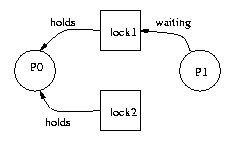
|
UNIVERSITY OF WISCONSIN-MADISON
Computer Sciences Department | ||
|
CS 537
Spring 2001 | A. Arpaci-Dusseau | |
| Quiz #5: March 21st -- Deadlock |
| Name: | Student ID #: |
a. Mutual exclusion
b. Hold and wait
c. No preemption
d. Circular wait
_d_ Impose a total ordering (or ranking) on how resources are acquired
_c_ When a process requests a resource that is already held,
force the process holding the resource to release it
_b_ Only allow a process to request a resource when the process has none
_a_ Allow all processes to access the resource simultaneously
_b_ Require each process to grab all desired resources at once
Can running each of the following code segments lead to deadlock of process 0 and process 1? Simply answer "yes" or "no".
Code Sample 1 Process 0: Process 1: lock1.acquire(); lock1.acquire(); lock2.acquire(); lock2.acquire(); lock1.release(); lock1.release(); lock2.release(); lock2.release();No deadlock possible, because there is no circularity of requests. Both processes grab the locks in the same order. |
Code Sample 2 Process 0: Process 1: lock1.acquire(); lock2.acquire(); lock2.acquire(); lock1.acquire(); lock1.release(); lock1.release(); lock2.release(); lock2.release();Deadlock is possible, because there is circularity. If process 0 acquires lock1 and then process 1 acquires lock2, both will be stuck holding one lock while waiting for the other. |
Code Sample 3 Process 0: Process 1: lock1.acquire(); lock2.acquire(); lock2.acquire(); lock2.release(); lock1.release(); lock1.acquire(); lock2.release(); lock1.release();No deadlock possible, because process 1 does not hold and wait. Even if process 0 acquires lock1 and process 1 acquires lock2, eventually process 1 will release lock2, at which point process 0 will be able to acquire lock 2. |
Running which of the above code samples could lead to the situation shown in the following resource-allocation graph? Indicate all of the possible code samples that apply.

Possible with Code Sample 1 given the following execution:
Process 0: Process 1:
lock1.acquire();
lock2.acquire();
lock1.acquire(); // waits!
|
Not possible with Code Sample 2; if Process 1 is waiting for lock1, it must hold lock2, which isn't shown in the figure.
Possible with Code Sample 3 given the following execution:
Process 0: Process 1:
lock2.acquire();
lock2.release();
lock1.acquire();
lock2.acquire();
lock1.acquire(); // waits!
|